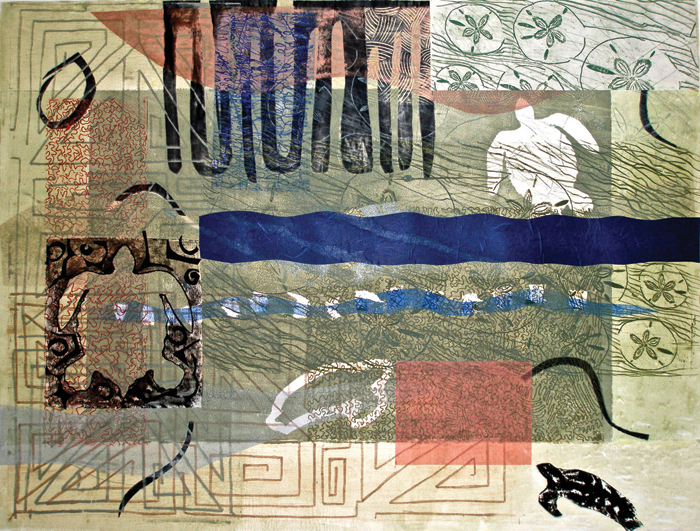Carolyn Shattuck
Compass Music and Arts Center – Brandon, VT – cmacvt.org/ – Through September 14, 2019
Carolyn Shattuck is a consummate printmaker, using monotype, dry point, painting, stencils and mixed media to achieve her unique results. Some pieces rely on highly defined patterns for effect. Other works are more painterly. Shattuck’s work is bold, exploratory and questioning. Despite titles that sometimes point the viewer in the direction of the artist’s intent, different layers of meaning reveal themselves upon deeper looking.
In Turtle Series II, there is a progression through the piece, as the turtle changes color and form, starting out as black, passing through a complex world and evolving into transparent white at the top. The entire mixed-media print, in subtle shades of green-grey, with currents of blue and mysterious patterns has the fluidity of water. The inclusion of a calligraphic open circle brings a sense of peace to the journey.

Carolyn Shattuck, Turtle Series II, 2008, collage, Japanese papers, dry point, monotype, 35 x 27″. Courtesy of the artist.
Interior I, a painterly work, has a Matisse-like feel, with its emphasis on color and space. Blue circles with bright yellow centers are mesmerizing with their liquid sense of seeping into the paper. The central mug and bottle cast long, dark shadows onto a highly patterned tablecloth. The complex layering of foreground and background is a result of the transparency that printmaking allows.
In addition to her printmaking skills, Shattuck is architectural in the way she plans and executes the intricate constructions for her sculptural books, which highlight her interest in social and environmental causes. In Triple Decker, she deftly interweaves ethnic patterns, a clothesline and cut out people to reference 19th and 20th-century immigrant life. Wardrobe Chronicles and Women Helping Women speak to raising awareness of women’s rights. The Urn Book unfolds into a series of New England gravestones interspersed with original inscriptions and quotes referencing the essential nature of change, loss and renewal.
Shattuck’s work sometimes springs from painful personal experience yet becomes universal as she integrates the process of healing into her art. The resultant pieces are rich tapestries, incorporating dense bright colors and multiple patterns. A sense of wonder and question is inherent in the work and Shattuck never disappoints. She entices us on to the next journey.
